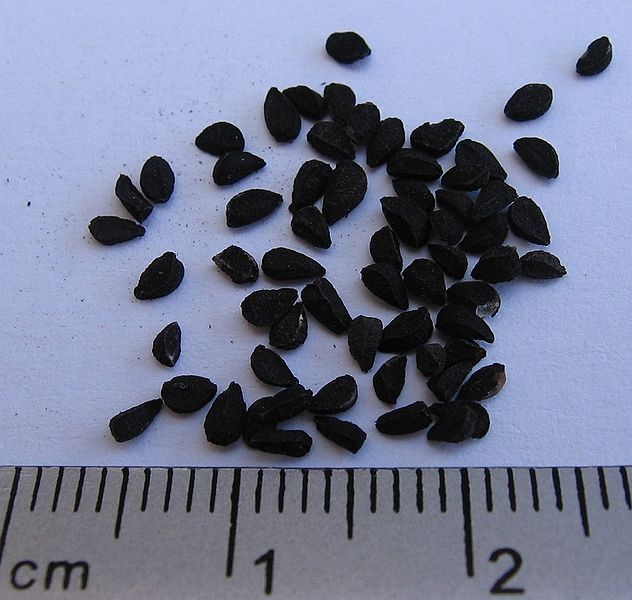Nigella sativa
[size=75]From Wikipedia, the free encyclopedia [/size]
Nigella sativa is an annual flowering plant, native to southwest Asia. It grows to 20-30 cm tall, with finely divided, linear (but not thread-like) leaves. The flowers are delicate, and usually coloured pale blue and white, with 5-10 petals. The fruit is a large and inflated capsule composed of 3-7 united follicles, each containing numerous seeds. The seed is used as a spice.
Nigella sativa seed is known variously as kalonji कलौंजी or कलोंजी (Hindi), kezah קצח (Hebrew), chernushka (Russian), çörek otu (Turkish), habbah Albarakah, حبه البركة (literally seeds of blessing Arabic) or siyah daneh سیاهدانه (Persian). In English it is called fennel flower, black caraway, nutmeg flower, Roman coriander, or black onion seed. Other names used, sometimes misleadingly, are onion seed and black sesame (both of which are similar-looking but unrelated). Frequently the seeds are referred to as black cumin, this is, however, also used for a different spice, Bunium persicum. It is also sometimes just referred to as nigella, blackseed or black seed. The name is a derivative of Latin niger, black.[1] An old English name gith is now used for the corncockle.
This potpourri of vernacular names for this plant reflects that its widespread use as a spice is relatively new in the English speaking world, and largely associated with immigrants from areas where it is well known. Increasing use is likely to result in one of the names winning out, hopefully one which is unambiguous.
Nigella sativa has a pungent bitter taste and a faint smell of strawberries. It is used primarily in candies and liquors. The variety of naan bread called Peshawari naan is as a rule topped with kalonji seeds. In herbal medicine, Nigella sativa has hypertensive, carminative, and anthelminthic properties. They are eaten by elephants to aid digestion.
According to Zohary and Hopf, archeological evidence about the earliest cultivation of N. sativa “is still scanty”, but they report seeds of this condiment have been found in several sites from ancient Egypt including Tutenkhamen’s tomb.[1] Although its exact role in Egyptian culture is unknown, we do know that items entombed with a pharaoh were carefully selected to assist him in the after life.
The earliest written reference to N. sativa is found in the book of Isaiah in the Old Testament. Isaiah contrasts the reaping of nigella with wheat (Isaiah 28: 25, 27). Easton’s bible dictionary clarifies that the Hebrew word for nigella, ketsah, refers to without doubt N. sativa. According to Zohary and Hopf, N. sativa “was another traditional condiment of the Old World during classical times; and its black seeds were extensively used to flavour food.”[2]
In the Unani Tibb system of medicine, N. sativa has been regarded as a valuable remedy in a number of diseases. Ibn Sina, most famous for his volumes called The Canon of Medicine regarded by many as the most famous book in the history of medicine, refers to nigella as the seed that stimulates the body’s energy and helps recovery from fatigue and dispiritedness and several therapeutic effects on digestive disorders, gynecological diseases and respiratory system have been ascribed to the seeds of N. sativa (Ave-sina). It is also included in the list of natural drugs of ‘Tibb-e-Nabavi’, or “Medicine of the Prophet (Muhammad)”, according to the tradition “hold onto the use of the black seeds for in it is healing for all diseases except death” (Sahih Bukhari vol. 7 book 71 # 592).
The seeds have been traditionally used in the Middle East and Southeast Asian countries to treat ailments including Asthma, Bronchitis, Rheumatism and related inflammatory diseases, to increase milk production in nursing mothers, to promote digestion and to fight parasitic infections. Its oil has been used to treat skin conditions such as eczema and boils and to treat cold symptoms. The many uses of nigella has earned for this ancient herb the Arabic approbation ‘Habbatul barakah’ meaning the seed of blessing.

